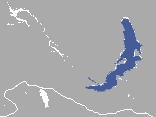Baikal seal
| Baikal seal | |
|---|---|
 |
|
| Scientific classification | |
| Kingdom: | Animalia |
| Phylum: | Chordata |
| Class: | Mammalia |
| Order: | Carnivora |
| Family: | Phocidae |
| Genus: | Pusa |
| Species: | P. sibirica |
| Binomial name | |
|
Pusa sibirica Gmelin, 1788 |
|
 |
|
| Baikal seal range | |
| Synonyms | |
|
Phoca sibirica |
|
Phoca sibirica
The Baikal seal, Lake Baikal seal or nerpa (Pusa sibirica), is a species of earless seal endemic to Lake Baikal in Siberia, Russia. Like the Caspian seal, it is related to the Arctic ringed seal. The Baikal seal is one of the smallest true seals and the only exclusively freshwater pinniped species. A subpopulation of inland harbour seals living in the Hudson's Bay region of Quebec, Canada (lac de loups marins harbour seals), the Saimaa ringed seal (a ringed seal subspecies) and the Ladoga seal (a ringed seal subspecies) are found in fresh water, but these are part of species that also have marine populations. It remains a scientific mystery how the seals originally came to Lake Baikal, hundreds of kilometers from any ocean.
The most recent population estimates are 80,000-100,000 animals, roughly equaling the expected carrying capacity of the lake. At present, the species is not considered threatened, despite hunting (both legal and illegal) and heavy pollution of the lake.
The Baikal seal is one of the smallest true seals. Adults grow to around 1.3 m (4 ft 3 in) in length with a body mass from 63 to 70 kg (139 to 154 lb). The animals show very little sexual dimorphism; males are only slightly larger than females. They have a uniform, steely-grey coat on their backs and fur with a yellowish tinge on their abdomens. As the coat weathers, it becomes brownish. When first born, pups weigh around 4.5 kg (9.9 lb) and have coats of white, silky, natal fur. This fur is quickly shed and exchanged for a darker coat, much like that of adults. Rarely, Baikal seals can be found with spotted coats.
The Baikal seal lives only in the waters of Lake Baikal. It is something of a mystery how Baikal seals came to live there in the first place. They may have swum up rivers and streams or possibly Lake Baikal was linked to the ocean at some point through a large body of water, such as the West Siberian Glacial Lake or West Siberian Plain, formed in a previous ice age. The seals are estimated to have inhabited Lake Baikal for some two million years.
...
Wikipedia

